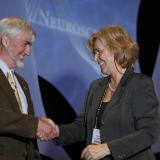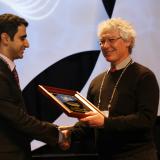2008 Gruber Neuroscience Prize
John O'Keefe and his colleagues have found that the brain's mapping system creates the sense of place by integrating information from different environmental landmarks. Since this discovery, work in many laboratories around the world has begun to uncover aspects of the synaptic plasticity and cellular pathways which enable the hippocampus to remember places in the environment. O'Keefe has recently applied extensive knowledge of place cell behavior and hippocampal spatial function to the study of diseases of memory, in particular Alzheimer's disease.
2008 Neuroscience Prize Recipient
Laureate Profile
John O'Keefe has had a lifetime interest in understanding the functions of the limbic system, the part of the brain involved in memory and emotions. During his PhD work at McGill University, he developed the techniques for recording from single cells in the brains of freely-moving animals.
Shortly after arriving at University College London, he switched his attention to the hippocampus which was already known to be involved in the storage of memories. He discovered that hippocampal cells responded selectively to the animal’s spatial location and called these cells place cells.
"The existence of a class of cells with such abstract properties, together with other aspects of hippocampal anatomy and physiology, suggested that this part of the brain might function as a cognitive map." O'Keefe says. The cognitive map theory elaborated with Lynn Nadel is now one of the dominant theoretical paradigms in the study of hippocampal function.
The theory predicted the existence of cells in the hippocampal formation representing distance and direction which would bind together the place representations into a map-like structure. Both cell types are now known to exist. The cognitive map theory also predicted a selective deficit in spatial memory following hippocampal damage and O'Keefe's laboratory was the first to confirm this.
Recently, O'Keefe's team has shown that place cells serve as the basis for spatial memories: they initially treat differently-shaped environments as similar but learn to discriminate between them with repeated experience.
"For many years, I have been interested in the philosophical implications of findings and theories in the field of neuroscience," O'Keefe says. "I believe that our sense of objective three-dimensional space is given to us by the brain and is not a property of the physical world, a theory originally proposed by Immanuel Kant."
Citation
The Peter and Patricia Gruber Foundation is proud to present the 2008 Neuroscience Prize to John O'Keefe for his pioneering work concerning the neural basis of complex cognitive functions in freely moving animals.
His seminal discovery that neurons of the hippocampus respond selectively to the animal's spatial location enabled him and his colleagues to develop a theoretical framework and computational models for how the hippocampus participates in memory, and to validate these ideas empirically in rodents and humans.
The discovery of place cells and their abstract mnemonic properties was a vital milestone in the development of the field of cognitive neuroscience. John O'Keefe's work inspired the research of many others in the field of memory and served as an exemplar of the application of physiological and computational approaches to the understanding of behavior.























